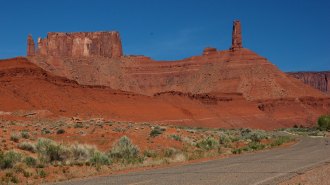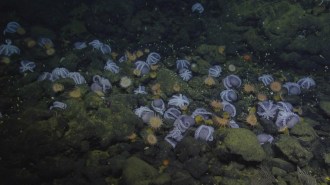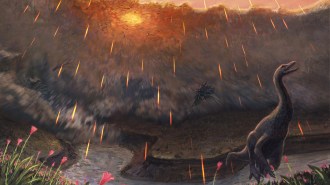Search Results
Ice cream under the microscope
Students will analyze and write a caption for microscope images of crystals in an ice cream–like solution, discuss how molecules behave as ice cream freezes and thaws, and pose scientific questions about one of their favorite frozen desserts.
The scoop on ice cream science
Students will answer questions about the online Science News article “Grainy ice cream is unpleasant. Plant-based nanocrystals might help,” which describes new research into improving the shelf life of ice cream. A version of the article, “Cellulose helps ice cream go down smooth,” appears in the May 7, 2022 & May 21, 2022 issue of Science News.
Making sense of animal worlds
In this activity, students will discuss how literary devices can be used to convey scientific concepts, research how an animal of their choice senses the world and compose a piece of creative writing based on what they find.

Climbers Help Scientists Vibe With Utah’s Rocks
In this guide, students will learn about a citizen science project that is helping scientists better understand the physical properties of rock formations. Students will then explore other citizen science projects that they could participate in based on their hobbies and interests.
Citizens for science
Students will explore the concept of citizen science and use their hobbies and interests to find a citizen science project they could participate in.
Joining forces for rock science
Students will answer questions about the online Science News article “How climbers help scientists vibe with Utah’s famous red rock formations,” which describes how researchers teamed up with rock climbers to collect data that can help assess the seismic stability of red rock formations in Utah. A version of the article, “Climbers help scientists vibe with Utah’s rocks,” appears in the April 23, 2022 issue of Science News.
Exploring STEM career paths
After considering their interests and skills, students will identify potential STEM careers that they might want to pursue and create a map or flowchart showing how they might reach that goal. Students will then use the Science News archive and other online resources to research a STEM professional whose career resembles one that students might choose for themselves.

Deep-sea ‘Octomoms’ Seek the Heat
In this guide, students will answer questions about how scientists discovered that octopuses laying eggs in warm waters near geothermal springs are speeding up hatching. Students will then define rates and their units of measurement for biological and chemical processes and discuss factors that affect rates.
Rates and what affects them
Students will define rates and their units of measurement for biological and chemical processes before discussing factors that affect rates.
Octopus moms seek the heat
Students will answer questions about the Science News article “Some deep-sea octopuses aren’t the long-haul moms scientists thought they were,” which describes how octopuses laying eggs in warm waters near geothermal springs speed up hatching. A version of the article, “Deep-sea ‘octomoms’ seek the heat,” appears in the April 9, 2022 issue of Science News.
Century of Science scavenger hunt
Students will use the clues provided and the Science News Century of Science website to explore how science advances. After making connections across scientific subtopics, student groups will research and present highlights of discoveries from an assigned decade.

The Age of Dinosaurs May Have Ended in Springtime
In this guide, students will answer claim, evidence and reasoning questions about how scientists used the bones of ancient fish to determine during what season an asteroid wiped out nonavian dinosaurs. They will then explore the physical properties of human bones and how bones offer evidence to support scientific claims.